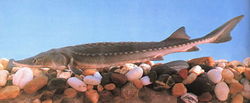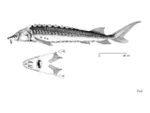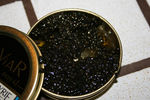| Sturgeon |
 |
| Scientific Classification |
|
|
| Species |
- A. baerii
- A. brevirostrum
- A. dabryanus
- A. fulvescens
- A. gueldenstaedtii
- A. medirostris
- A. mikadoi
- A. naccarii
- A. nudiventris
- A. oxyrinchus
- A. persicus
- A. ruthenus
- A. schrenckii
- A. sinensis
- A. stellatus
- A. sturio
- A. transmontanus[1]
|
| Image Description |
Sturgeons have a heterocercal tail and their body is covered with five bony plates. They are mostly found in the Northern hemisphere in cool to temperate waters. They live in brackfish, marine and fresh waters. All the Sturgeon species have six life stages. During their adult stage they average from 2 to 8 meters based on the species. They often feed on lampreys and eels. Some baits that are quite often used on sturgeons are Salmon Roe, Mud Shrimps and Lamprey. Only the Beluga, Osetra, and Sevruga sturgeons have caviar. The inside of sturgeons swim bladder is used to make isinglass which is a pure kind of gelatin used by industries.
Body Design

Two view of a Sturgents body design.
Sturgeon have a heterocercal tail(When the upper lobe is much longer than the lower lobe. Their bodies are covered with 5 rows of large bony plates.[2]
They have 50 or less gill rakers. Adults have no teeth(toothless). They also have vast swim bladder. The female eggs are small, sticky, and multitudinous.[3]
Sturgeons range about from as small as 2 Meters to about 8 Meters depending on their species. Sturgeon have 4 sensitive tactile barbels, that help them find food along the bottom of the ocean. .[4]
Tails of Sturgeons and also sharks are asymmetrical and make an upward-directed torque which prevents them from sinking. .[5]
Some sturgeons have minor difference; like Green Sturgeons, the barbells are closer to mouth than the tip of the snout while for the White Sturgeons the barbells are closer to the tip of snout than to mouth [6]
Life Cycle
All sturgeon have six life stages. The first is embryo, the second stage is yolk sac larvae, and the third stage is when theirs larvae. The fourth stage happens when they become a fingerling. The fifth stage is when they are called juvenile, or sub-adult. And the last stage is when they grow up and become adult.In the first stage, if they survive, they turn into fish. The second stage is the yolk sac stage. They have the yolk sac so they can eat, since they are too young to hunt. Once the yolk sac is gone they enter into the larvae or fry stage. Without the yolk sac they are free. They can look for food and move around.
Then they grow into the fingerling stage, this stage is called this because they are as big as a human finger. They may even migrate downstream and stay there for a while at this young stage. The next stage is the juvenile or sub adult. This is just the one small stage before adult hood. The last stage is adulthood. Once they reach this stage they are able to reproduce. [7]
Ecology

Range Map of Acipenseridae
Sturgeon reproduce and live in different environments which are Fresh, Brackish, and marine waters.[8] Because of the abundance of sturgeon in the water they are over-fished by industries. Some places highly restrict over-fishing of Sturgeon, and so they put a boundary for the limit of catching sturgeon.[9] They live mostly in the cold to temperate waters in the Northen Hemisphere.[8]
Most sturgeons migrate and then spawn in fresh water. The feed brackish waters of estuaries. The usually migrate against coastline. Some sturgeons only stay in freshwater. Some sturgeons like [Lake Sturgeons] live in deep pools or in the deepest part of channels. [10] Surgeons eat mostly invertebrates, insects, crustaceans, mollusks, and snails. They also eat lampreys and eels.[11] Some sturgeons are eaten by catfish, suckers, and sometimes they eaten by other sturgeons. [12]
Caviar
Caviar are brine-cured eggs of the acipenseridae family. [13] There are only three kinds of sturgeon fish who carry caviar. They are Beluga, Osetra, and sevruga. The best supremacy caviar comes from the Caspian Sea. Largest and oldest Caviar fisheries and factories are in Astrakhan, Russia. Some these fisheries are up to 200 years of age. [14]The inside of swim bladder is used to make isinglass which is a pure kind of gelatin used by industries. [9]
Video
Giant 12 foot Sturgeon
References
- ↑ Acipenseriformes Wikispecies. Web. Last modified on 14 May 2011. Unknown Author
- ↑ Fact Sheet: SHORTNOSE STURGEON FishBase. Web. Accessed April 6,2014 Author Unknown.
- ↑ Family Acipenseridae - Sturgeons Army.Mil. Web. Accessed April 6,2014 Author Unknown.
- ↑ sturgeon Encyclopedia Britannica. Web. Accessed April 6,2014 Author Unknown.
- ↑ Tail prevents sinking: sturgeons Ask Nature. Web. Accessed April 6,2014 Author Unknown.
- ↑ Marine Sportfish Identification: Other Fishes California Department of Fish and Wildlife. Web. Last Updated October 17, 2013 Author Unknown.
- ↑ Sturgeon Life Cycle Fact Sheet NOAA. Web. Accessed April 6, 2014 Author Unknown.
- ↑ 8.0 8.1 Family Acipenseridae - Sturgeons FishBase. Web. Access April 6,2014 Author Unknown.
- ↑ 9.0 9.1 . sturgeon Encyclopedia Britannica. Web. Accessed April 6, 2014 Author Unknown.
- ↑ Lake Lake sturgeon Fishes of Minnesota. Web. Accessed bApril 6, 2014 Unknown Author.
- ↑ . What Do Sturgeons Eat? Yukozimo. Web. Accessed April 6, 2014 Author Unknown.
- ↑ Lake Lake sturgeon Fishes of Minnesota. Web. Accessed bApril 6, 2014 Unknown Author.
- ↑ Caviar Wikipedia. Web. Lastupdate 31 March 2014 Author Unknown.
- ↑ Some interesting facts about caviar Fine Food Delicatessen. Web. Accessed April 6, 2014 Author unknown.




